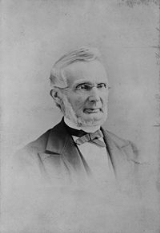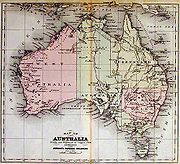
Arnold Henry Guyot
Encyclopedia

Switzerland
Switzerland name of one of the Swiss cantons. ; ; ; or ), in its full name the Swiss Confederation , is a federal republic consisting of 26 cantons, with Bern as the seat of the federal authorities. The country is situated in Western Europe,Or Central Europe depending on the definition....
-American geologist
Geologist
A geologist is a scientist who studies the solid and liquid matter that constitutes the Earth as well as the processes and history that has shaped it. Geologists usually engage in studying geology. Geologists, studying more of an applied science than a theoretical one, must approach Geology using...
and geographer
Geographer
A geographer is a scholar whose area of study is geography, the study of Earth's natural environment and human society.Although geographers are historically known as people who make maps, map making is actually the field of study of cartography, a subset of geography...
.
Biography
Guyot was born at BoudevilliersBoudevilliers
Boudevilliers is a municipality in the district of Val-de-Ruz in the canton of Neuchâtel in Switzerland.-Geography:Boudevilliers has an area, , of . Of this area, or 61.3% is used for agricultural purposes, while or 32.2% is forested...
, near Neuchâtel, Switzerland
Switzerland
Switzerland name of one of the Swiss cantons. ; ; ; or ), in its full name the Swiss Confederation , is a federal republic consisting of 26 cantons, with Bern as the seat of the federal authorities. The country is situated in Western Europe,Or Central Europe depending on the definition....
. He was educated at Chaux-de-Fonds, then at the college of Neuchâtel. In 1825, he went to Germany, and resided in Karlsruhe
Karlsruhe
The City of Karlsruhe is a city in the southwest of Germany, in the state of Baden-Württemberg, located near the French-German border.Karlsruhe was founded in 1715 as Karlsruhe Palace, when Germany was a series of principalities and city states...
where he met Louis Agassiz
Louis Agassiz
Jean Louis Rodolphe Agassiz was a Swiss paleontologist, glaciologist, geologist and a prominent innovator in the study of the Earth's natural history. He grew up in Switzerland and became a professor of natural history at University of Neuchâtel...
, the beginning of a lifelong friendship. From Karlsruhe he moved to Stuttgart
Stuttgart
Stuttgart is the capital of the state of Baden-Württemberg in southern Germany. The sixth-largest city in Germany, Stuttgart has a population of 600,038 while the metropolitan area has a population of 5.3 million ....
, where he studied at the gymnasium
Gymnasium (school)
A gymnasium is a type of school providing secondary education in some parts of Europe, comparable to English grammar schools or sixth form colleges and U.S. college preparatory high schools. The word γυμνάσιον was used in Ancient Greece, meaning a locality for both physical and intellectual...
. He returned to Neuchâtel in 1827. He determined to enter the ministry and started for the University of Berlin
Humboldt University of Berlin
The Humboldt University of Berlin is Berlin's oldest university, founded in 1810 as the University of Berlin by the liberal Prussian educational reformer and linguist Wilhelm von Humboldt, whose university model has strongly influenced other European and Western universities...
to attend lectures. While pursuing his studies, he also attended lectures on philosophy and natural science. His leisure was spent in collecting shells and plants, and he received an entrée to the Berlin Botanical Garden from Humboldt
Alexander von Humboldt
Friedrich Wilhelm Heinrich Alexander Freiherr von Humboldt was a German naturalist and explorer, and the younger brother of the Prussian minister, philosopher and linguist Wilhelm von Humboldt...
. In 1835, he received the degree of Ph.D.
Ph.D.
A Ph.D. is a Doctor of Philosophy, an academic degree.Ph.D. may also refer to:* Ph.D. , a 1980s British group*Piled Higher and Deeper, a web comic strip*PhD: Phantasy Degree, a Korean comic series* PhD Docbook renderer, an XML renderer...
from Berlin.
In 1838, at Agassiz's suggestion, he visited the Swiss glaciers and communicated the results of his six weeks' investigation to the Geological Society of France. He was the first to point out certain important observations relating to glacial motion
Glacial motion
Glacial motion is the motion of glaciers, which can be likened to rivers of ice. It has played an important role in sculpting many landscapes. Most lakes in the world occupy basins scoured out by glaciers...
and structure. Among other things he noted the more rapid flow of the center than of the sides, and the more rapid flow of the top than of the bottom of glaciers; described the laminated or ribboned structure of the glacial ice; and ascribed the movement of glaciers to a gradual molecular displacement rather than to a sliding of the ice mass as held by de Saussure
Horace-Bénédict de Saussure
200px|thumb|Portrait of Horace-Bénédict de Saussure Horace-Bénédict de Saussure was a Genevan aristocrat, physicist and Alpine traveller, often considered the founder of alpinism, and considered to be the first person to build a successful solar oven.-Life and work:Saussure was born in Conches,...
. He subsequently collected important data concerning erratic boulders.
In 1839, he became the colleague of Agassiz as professor of history and physical geography at the College of Neuchâtel (a.k.a. Neuchâtel Academy?). The suspension of that institution in 1848 caused Guyot to emigrate, at Agassiz's instance, to the United States
United States
The United States of America is a federal constitutional republic comprising fifty states and a federal district...
, where he settled in Cambridge, Massachusetts
Cambridge, Massachusetts
Cambridge is a city in Middlesex County, Massachusetts, United States, in the Greater Boston area. It was named in honor of the University of Cambridge in England, an important center of the Puritan theology embraced by the town's founders. Cambridge is home to two of the world's most prominent...
. He delivered a course of lectures at the Lowell Institute
Lowell Institute
The Lowell Institute is an educational foundation in Boston, Massachusetts, U.S.A., providing for free public lectures, and endowed by the bequest of $250,000 left by John Lowell, Jr., who died in 1836. Under the terms of his will 10% of the net income was to be added to the principal, which in...
which were afterward published as Earth and Man (Boston 1853). For several years the Massachusetts Board of Education
Massachusetts Board of Education
The Massachusetts Board of Education is the state education agency responsible for interpreting and implementing laws relevant to public education in the Commonwealth of Massachusetts. Public education in the Commonwealth is organized according to the regulations adopted by the BOE, which are good...
retained his services as a lecturer on geography and methods of instruction to the normal schools and teachers' institutes.
He was occupied with this work until his appointment, in 1854, as professor of physical geography and geology at Princeton University
Princeton University
Princeton University is a private research university located in Princeton, New Jersey, United States. The school is one of the eight universities of the Ivy League, and is one of the nine Colonial Colleges founded before the American Revolution....
, which office he retained until his death. He was also for several years lecturer on physical geography in the State Normal School in Trenton, New Jersey
Trenton, New Jersey
Trenton is the capital of the U.S. state of New Jersey and the county seat of Mercer County. As of the 2010 United States Census, Trenton had a population of 84,913...
, and from 1861 to 1866 lecturer in the Princeton Theological Seminary. He also gave courses in the Union Theological Seminary
Union Theological Seminary in the City of New York
Union Theological Seminary in the City of New York is a preeminent independent graduate school of theology, located in Manhattan between Claremont Avenue and Broadway, 120th to 122nd Streets. The seminary was founded in 1836 under the Presbyterian Church, and is affiliated with nearby Columbia...
, New York, and at Columbia College. He founded the museum at Princeton, many of the specimens of which are from his own collections.
His scientific work in the United States included the perfection of plans for a national system of meteorological
Meteorology
Meteorology is the interdisciplinary scientific study of the atmosphere. Studies in the field stretch back millennia, though significant progress in meteorology did not occur until the 18th century. The 19th century saw breakthroughs occur after observing networks developed across several countries...
observations. Most of these were conducted under the auspices of the Smithsonian Institution
Smithsonian Institution
The Smithsonian Institution is an educational and research institute and associated museum complex, administered and funded by the government of the United States and by funds from its endowment, contributions, and profits from its retail operations, concessions, licensing activities, and magazines...
. His extensive meteorological observations led to the establishment of the United States Weather Bureau, and his Meteorological and Physical Tables (1852, revised ed. 1884) were long standard.
Writings
His graded series of text-books and wall-maps were important aids in the extension and popularization of geological study in America. In addition to text-books, his principal publications were:- Earth and Man, Lectures on Comparative Physical Geography in its Relation to the History of Mankind (translated by Cornelius Conway FeltonCornelius Conway FeltonCornelius Conway Felton was an American educator. He was regent of the Smithsonian Institution, as well as professor of Greek literature and president of Harvard University....
, 1849) - A Memoir of Louis Agassiz (1883)
- Creation, or the Biblical Cosmogony in the Light of Modern Science (1884).
- Johnson’s New Universal Cyclopaedia (1876) - editor-in-chief along with Frederick Augustus Porter Barnard
Namesakes
He is the namesake of several geographical features, including Guyot GlacierGuyot Glacier
Guyot Glacier is a long and wide glacier located in the east end of the Robinson Mountains in the U.S. state of Alaska. It begins north of Yaga Peak and heads east-southeast to Icy Bay, south of the Guyot Hills and northwest of Yakutat. It borders Yahtse Glacier on the northeast. The glacier...
in Alaska
Alaska
Alaska is the largest state in the United States by area. It is situated in the northwest extremity of the North American continent, with Canada to the east, the Arctic Ocean to the north, and the Pacific Ocean to the west and south, with Russia further west across the Bering Strait...
, Mount Guyot
Mount Guyot (Great Smoky Mountains)
Mount Guyot is a mountain in the eastern Great Smoky Mountains, located inthe southeastern United States. At above sea level, Guyot is the fourth-highestsummit in the eastern U.S., and the second-highest in the Great Smoky Mountains National Park...
in North Carolina, and a different Mount Guyot
Mount Guyot (New Hampshire)
Mount Guyot is a mountain located in Grafton County, New Hampshire. The mountain is named after Professor Arnold H. Guyot of Princeton University, and is part of the Twin Range of the White Mountains....
in New Hampshire. The building housing the Department of Geosciences at Princeton is named Guyot Hall in his honor.
External links
- Tables, Meteorological and Physical Prepared for the Smithsonian Institution (1858)
- Tables, Meteorological and Physical Prepared for the Smithsonian Institution (1884)
- Directions for meteorological observations, and the registry of periodical phenomena (1860)
- Physical Geography (1873)
- The earth and man: lectures on comparative physical geography, in its relation to the history of mankind (1860).

